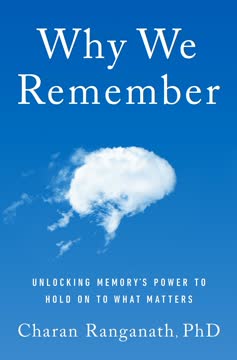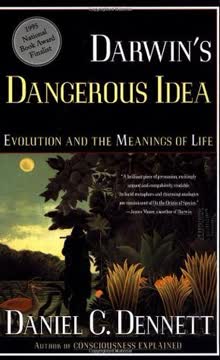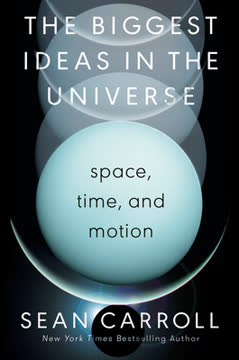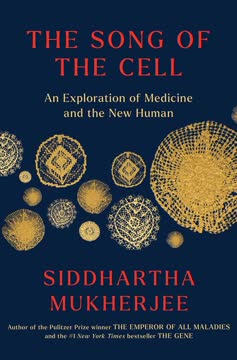Key Takeaways
1. Consciousness is a product of evolution, rooted in movement
The entire purpose of the brain is to make efficient movement from experience, and everything else, including consciousness, is downstream of these efforts.
Movement as foundation. Consciousness evolved primarily to control and coordinate movement. The brain's fundamental purpose is to predict and execute efficient actions based on past experiences. This includes not just physical motion, but also mental simulations of potential movements and their outcomes.
Evolutionary timeline. The progression from single-celled organisms to complex conscious beings followed a path of increasing motion control:
- Single cells exploiting chemical gradients
- Multicellular organisms developing specialized movement cells
- Simple nervous systems coordinating basic reflexes
- Complex brains capable of planning and simulating actions
Efficiency through prediction. Consciousness allows organisms to:
- Anticipate outcomes of potential actions
- Simulate scenarios without physical risk
- Learn from past experiences to optimize future movements
- Coordinate complex sequences of actions
2. The brain constantly predicts and simulates to navigate reality
What we call "thinking," thus, is manipulation of practice gestures, where gestures are thoughts derived from learning loops and conscious thoughts can be manipulated as inputs to a radio broadcast, a network of causes and effects, a collapse of quantum uncertainty, or a lie.
Predictive processing. The brain is constantly generating predictions about the world and comparing them to incoming sensory data. This predictive model helps us efficiently navigate reality by:
- Filling in gaps in sensory information
- Anticipating likely outcomes
- Focusing attention on unexpected or important stimuli
Mental simulation. Much of our conscious experience involves running mental simulations:
- Imagining potential future scenarios
- Replaying and analyzing past events
- Testing hypothetical actions and their consequences
- Practicing skills mentally
Embodied cognition. Our thoughts and perceptions are deeply rooted in our physical experiences:
- Abstract concepts often have physical metaphors (e.g., "grasping" an idea)
- Mental simulations activate similar neural pathways as physical actions
- Our understanding of the world is shaped by our bodily interactions with it
3. Consciousness arises from coordinated neural oscillations
Consciousness is a result of the neural beats, called oscillations, that coordinate cellular activity across its surface and deeply across its poles.
Brain rhythms. Neural oscillations, or brain waves, play a crucial role in coordinating activity across different brain regions. These rhythms occur at various frequencies, each associated with different cognitive states and functions:
- Delta waves (0.5-4 Hz): Deep sleep, unconsciousness
- Theta waves (4-8 Hz): Memory, emotional processing
- Alpha waves (8-13 Hz): Relaxed wakefulness, meditation
- Beta waves (13-30 Hz): Active thinking, focus
- Gamma waves (30-100 Hz): Higher cognitive functions, consciousness
Global workspace theory. Consciousness may emerge when information is "broadcast" widely across the brain through these oscillations, creating a unified experience from disparate sensory inputs and cognitive processes.
Temporal binding. Neural oscillations help synchronize activity across distant brain regions, allowing for the integration of information necessary for conscious experience:
- Coordinating sensory inputs from different modalities
- Linking perceptions with memories and emotions
- Enabling coherent thought and decision-making
4. Our perception of reality is a constructed simulation
We are in a simulation as both puppet and puppeteer and the literary and scientific questions, not coincidentally, are the same: Is it a first- or second-person simulation? How, if ever, will we know the difference?
Virtual reality model. Our conscious experience is not a direct representation of reality, but a highly processed simulation constructed by the brain:
- We perceive only a tiny fraction of available sensory information
- The brain fills in gaps and makes assumptions based on past experiences
- Our perception is optimized for survival and action, not absolute truth
Active perception. Perception is not a passive process, but an active construction:
- Eye movements constantly sample the environment
- Attention shapes what we consciously perceive
- Expectations and prior knowledge influence our interpretations
Limitations of perception:
- Change blindness: Failing to notice significant changes in a scene
- Inattentional blindness: Missing obvious stimuli when attention is focused elsewhere
- Perceptual illusions: Demonstrating the constructive nature of perception
5. Language and thought are extensions of motor control
Those extra few wires, which connected a chunk of brain required to swing through trees to the laryngeal cells that control muscles in the throat, meant that the muscles that allowed air to be bounced around and leave the mouth in various states of compression were not coordinated by dumb instinct but could learn a level of expert articulation as easily as the hand could.
Motor origins of language. The neural circuits underlying language likely evolved from those controlling complex motor actions:
- Areas of the brain involved in language overlap with motor control regions
- Gestures and vocalizations share neural substrates
- Language production activates motor planning areas
Thought as internalized action. Many cognitive processes can be understood as simulated or inhibited motor actions:
- Inner speech as inhibited vocalization
- Visual imagery as simulated eye movements
- Abstract reasoning as manipulation of mental objects
Embodied cognition in language:
- Use of spatial metaphors for abstract concepts (e.g., "high" status, "deep" thoughts)
- Gestural communication as a precursor to and complement of spoken language
- Motor system involvement in understanding action-related language
6. Consciousness can be understood through its physical substrates
Just as residents of a small town with only one well have a single source from which to draw water, the only possible place to find the "observer," whence free will and consciousness draw their power, is deep, deep down inside something called a microtubule, a paper-towel-rod-shaped thing that acts as a shield for the absolutely pure water inside it.
Materialist approach. Consciousness, despite its subjective nature, arises from physical processes in the brain:
- Neural correlates of consciousness: Identifying brain activity patterns associated with conscious experiences
- Integrated Information Theory: Proposing consciousness emerges from complex information integration
- Quantum consciousness theories: Exploring potential quantum effects in neural structures like microtubules
Levels of explanation:
- Molecular: Neurotransmitters, receptors, and cellular processes
- Cellular: Neuronal firing patterns and network dynamics
- Systems: Interactions between brain regions and large-scale networks
- Cognitive: Information processing and computational models
Experimental approaches:
- Brain imaging: fMRI, EEG, MEG to observe brain activity during conscious experiences
- Stimulation studies: Direct electrical stimulation of the brain to induce or alter conscious states
- Lesion studies: Examining changes in consciousness due to brain damage or surgical interventions
7. The hard problem: Why does consciousness feel like anything at all?
Why should consciousness feel like anything at all? Why, when an adult woman wakes up every morning, does it feel like she looks like something rather than nothing?
Explanatory gap. While we can describe the neural correlates and functional aspects of consciousness, explaining subjective experience remains challenging:
- How does physical brain activity give rise to qualitative experiences (qualia)?
- Why is there an "inner movie" accompanying our cognitive processes?
- Can a purely materialist account fully explain subjective experience?
Philosophical perspectives:
- Dualism: Consciousness as fundamentally separate from physical matter
- Panpsychism: Consciousness as a fundamental property of all matter
- Emergentism: Consciousness as an emergent property of complex systems
Scientific approaches:
- Neurophenomenology: Combining objective brain measurements with subjective reports
- Artificial consciousness: Attempting to create conscious machines to understand the required components
- Altered states research: Studying consciousness under various conditions (e.g., psychedelics, meditation)
8. Consciousness is likely infinitely variable across individuals
Some people claim to have no internal visual imagery; some see images in their head as a flickering slide reel; others as if the memory is happening to them from the vantage exactly as it once did; others watch their memories unfold from a few dozen meters away, through a single aperture, as if filming them; others as if they are watching a television one hundred feet away.
Spectrum of experiences. Consciousness varies widely between individuals in ways we're only beginning to understand:
- Mental imagery: From vivid internal "movies" to complete absence (aphantasia)
- Inner speech: Ranging from constant internal monologue to purely non-verbal thought
- Sensory perception: Differences in color perception, synesthesia, etc.
- Time perception: Variations in subjective experience of time passing
Implications:
- Challenges in studying consciousness due to individual differences
- Potential for personalized approaches to mental health and cognitive enhancement
- Philosophical questions about the nature of shared reality and communication
Factors influencing variation:
- Genetic differences
- Developmental experiences
- Cultural influences
- Neurological conditions and brain structure variations
9. Learning and simulation are key functions of consciousness
Consciousness evolved because it is an incomparable playground for learning. Mind wandering is not random. It is purposeful, careful, and efficient.
Adaptive advantage. Consciousness allows for complex learning and problem-solving:
- Mental simulation of potential scenarios without physical risk
- Integration of past experiences to inform future decisions
- Exploration of abstract concepts and hypothetical situations
Types of conscious learning:
- Explicit learning: Intentional acquisition of knowledge and skills
- Implicit learning: Unconscious pattern recognition and skill development
- Meta-learning: Learning how to learn more effectively
Mind wandering as functional:
- Default mode network activation during "idle" states
- Creative problem-solving and insight generation
- Memory consolidation and future planning
- Emotional regulation and self-reflection
10. The search for consciousness parallels scientific discovery
We are pre-telescope. Pre–Isaac Newton. Some of the biggest and best brain-reading devices in existence have not been the clear keyhole into the hallowed rooms of the mind that we had hoped for decades ago.
Historical parallels. The study of consciousness is at an early stage, similar to other scientific fields in their infancy:
- Astronomy before the telescope
- Biology before the microscope
- Physics before calculus
Current limitations:
- Lack of unified theory of consciousness
- Difficulty in objectively measuring subjective experiences
- Technological constraints in brain imaging and manipulation
Future directions:
- Development of more sophisticated brain imaging techniques
- Integration of insights from multiple disciplines (neuroscience, psychology, philosophy, computer science)
- Potential paradigm shifts in our understanding of consciousness, comparable to quantum mechanics or relativity in physics
Last updated:
Review Summary
Nineteen Ways of Looking at Consciousness receives mixed reviews. Some readers praise its unique approach, thought-provoking ideas, and engaging writing style, finding it a fascinating exploration of consciousness. Others criticize its disjointed structure, repetitive content, and occasionally confusing or pretentious prose. Many appreciate House's enthusiasm and ability to make complex concepts accessible, while some feel the book lacks scientific depth. Overall, it's seen as an intriguing but unconventional look at consciousness, best suited for readers open to philosophical and poetic perspectives rather than strictly scientific explanations.
Similar Books










Download PDF
Download EPUB
.epub digital book format is ideal for reading ebooks on phones, tablets, and e-readers.




